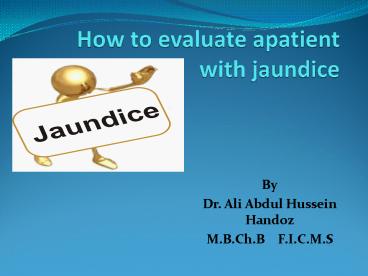How to evaluate apatient with jaundice - PowerPoint PPT Presentation
1 / 24
Title:
How to evaluate apatient with jaundice
Description:
Albumin. immunological tests: autoantibodies, 2- URINE urobilinogen in hemolytic jaundice or absent in obstructive jaundice (no more bile) conjugated ... – PowerPoint PPT presentation
Number of Views:1398
Avg rating:3.0/5.0
Title: How to evaluate apatient with jaundice
1
How to evaluate apatient with jaundice
- By
- Dr. Ali Abdul Hussein Handoz
- M.B.Ch.B F.I.C.M.S
2
Jaundice
- Definition
- Yellowish discoloration of skin and mucous
membranes due to staining with bilirubin. - Normal bilirubin 0.3 1.3 mg/dl.
- Conjugated (direct) 0.1 0.3 mg/dl.
- unconjugated (indirect) 0.2 0.7 mg/dl .
- jaundice detected clinically at level of gt 3
mg/dl.
3
(No Transcript)
4
(No Transcript)
5
(No Transcript)
6
Physiology of bilirubin
- -Break down of old RBCs in the RET releases HB
. - -In liver UB converted to conjugated (H2o
soluble), this is mediated by bilirubin UDP
glucuronyl transferase - -Conjugated bilirubin passes via biliary tree to
duodenum - -In small bowel
- conjugated bilirubin is deconjugated by
bacterial glucuronidase - unconjugated bilirubin is reduced to
urobilinogen
7
- Most of urobilinogen is excreted in faeces as
stercobilinogen. Some is reabsorbed and partly
excreted by liver (enterohepatic circulation) and
rest is excreted by kidneys .
8
(No Transcript)
9
(No Transcript)
10
Causes of jaundice (Hyperbilirubinaemia)
- Hyperbilirubinaemia result from
- Over production of bilirubin (haemolysis)
PREHEPATIC. - Impaired uptake, conjugation or excretion of
bilirubin HEPATIC. - Regurgitation of unconjugated or conjugated
bilirubin from damaged hepatocytes or bile ducts
POSTHEPATIC.
11
- Causes of unconjugated hyperbilirubinaemia
- Either overproduction (haemolysis)
- Or impairment of uptake
- Or impairment of conjugation
- Causes of conjugated hyperbilirubinaemia
- Either decreased excretion into bile ductules
- Or backward leakage of the pigment
(bilirubin)
12
Hepatocellular conditions that may produce
jaundice
- -viral hepatitis
- hepatitis A,B,C,D and E
- EBV
- CMV
- Herpes simplex
- -Drug toxicity
- Predictable, dose-dependent, e.g., acetaminophen
- Unpredictable, idosyncratic, e.g., isoniazid
- -alcohol
- -Environmental toxins
- vinyl chloride
- Wild mushrooms amanita phalloides or verna
- -Wilsons disease
- -autoimmune hepatitis
13
Cholestatic conditions that may produce jaundice
- 1-INTRAHEPATIC
- -viral hepatitis
- fibrosing cholestatic hepatitis B and C
- hepatitis
- EBV
- -Drug toxicity
- pure cholestasis anabolic and contraceptive
steroids - -alcoholic hepatitis
- -vanishing bile duct syndrome
- chronic rejection of liver transplants
- sarcoidosis
- drugs
- -inherited
- benign recurrent cholestasis
- -total parenteral nutrition
- -benign postoperative cholestasis
14
- 2 EXTRAHEPATIC
- A- Malignant
- -cholangio ca.
- -pancreatic ca.
- -gall bladder ca.
- -ampullary ca.
- -malignant involvement of the porta hepatis
lymph nodes - B- Benign
- -CBD stone (choledocholithiasis) the most
common - -1ry sclerosing cholangitis
- -chronic pancreatitis
- -AIDS cholangiopathy
- -Hydatid cyst
15
Evaluation
- HISTORY TAKING
- HPI
- -duration of the jaundice
- -onset
- sudden CBD stone, viral hepatitis
- gradual cirrhosis, pancreatic Ca.
- -pattern
- -pain
- painful CBD stone, pancreatic disease
- painless malignancy, viral hepatitis
(although there is dragging subcostal pain) - -history of
- blood transfusion
- anorexia
- wt. loss malignancy
- abdominal pain (RUQ)
- fever
16
- Past Hx
- Biliary surgery (stricture, residual stone)
- Social Hx
- alcohol
- Family Hx
- SCD G6PD
- spherocytosis
- Drug Hx
- hx of any hepatotoxic drug
17
Physical Examination
- General appearance
- Cachexia (muscle wasting gt in malignant
disease) - General examination
- stigmata of chronic liver disease.
- Abdominal examination
- heptomegaly
- spleenomegaly
- RUQ tenderness
- Murphys (ve)
18
INVESTIGATION
- 1- BLOOD
- serum bilirubin
- conjugated or unconjugated
- liver enzymes
- ALT
- AST
- ALP
- CBC
- Hb in hemolytic jaundice
- Reticulocytes
- Leucopenia viral hepatitis esp. HBV
aplastic anemia - Lymphocytes
- coagulation profiles
- serum antigens (hepatitis profile)
- -HBs Ag, HBe Ag ,..
19
- LDH (lactate dehydrogenase)
- found in muscles and RBCs.
- Albumin.
- immunological tests
- autoantibodies,
20
- 2- URINE
- urobilinogen
- in hemolytic jaundice
- or absent in obstructive jaundice (no more bile)
- conjugated bilirubin
- in obstructive (cholestatic) or
hepatocellular jaundice - Hb urea intravascular hemolysis
21
- 3- STOOL
- Pale stool in obstructive jaundice
- stercobilinogen
- in hemolytic jaundice
- or absent in obstructive jaundice (pale
stool) - occult blood
- carcinoma of GI (metastasis to liver)
- esophageal varices (2ry to liver cirrhosis)
22
- 4- RADIOLOGICAL INVESTIGATION
- US
- Gall stones
- Intrahepatic or extrahepatic biliary
dilation (due to obstruction by stone, stricture,
or tumor) - CT
- assessing the head of pancreas (if there is
Ca.) - identify stones in the distal CBD
- ERCP
- PTC
23
(No Transcript)
24
- THANK YOU































